U.S. Anxiously Shaping Contingency Options for Syrian Chemical Arsenal
- Share
Dec. 6, 2012
By Elaine M. Grossman
Global Security Newswire
Syrian President Bashar Assad, shown during a 2009 trip to Iran. The United States and its allies are preparing contingency plans for a number of scenarios related to Syria's chemical arsenal, according to U.S. officials and experts (AP Photo/Vahid Salemi).
WASHINGTON -- U.S. and allied officials have spent increasingly long hours over the past several days planning intensely for potential military and diplomatic responses in the event that the Syrian chemical weapons threat heightens, according to government sources and experts.
“There are essentially about 10 plans now in the works, each having a different flavor, each focusing on a different aspect of conflict, each committing the president to different options,” one defense expert with ties to Capitol Hill said this week. Details of the contingency plans are highly classified.
President Obama and his national security team -- including his top military commander for the Mideast region, sources said -- want to avoid U.S. armed intervention in the ongoing Syria civil war unless embattled President Bashar Assad unleashes his chemical arsenal.
Barring a poison gas incident that would cross a “red line” laid out by Secretary of State Hillary Clinton in public comments this week, “General [James] Mattis has strongly recommended against using any military forces, strongly,” said this defense expert.
At the same time, the Marine Corps general is taking the lead in planning how U.S. troops would respond if conditions in Syria demand it, according to sources.
Mattis, who leads U.S. Central Command, on Wednesday declined comment.
Several issue specialists and government officials this week requested anonymity to discuss sensitive military contingency planning. They described a heightened level of international diplomatic and military coordination following intelligence indications that Syria appeared to be preparing toxic chemicals capable of being weaponized. And, on Thursday, NBC News reported that Syrian gravity bombs were observed being loaded with sarin nerve gas.
“There are clearly options available to the president regarding military capabilities,” said retired Lt. Col. Anthony Shaffer, a former Army intelligence officer. “There is always the need -- and always consideration [of] -- worst-case scenarios.”
Neither Obama nor his secretary of State has spelled out all of the scenarios that might trigger U.S. or allied military intervention.
What is clear, though, is that a verified chemical attack by Assad’s forces against rebel fighters, the Syrian people or neighboring nations could draw Washington into the conflict after months of largely remaining on the sidelines.
The United States has provided humanitarian aid for Syrian opposition forces and displaced civilians, and more recently has begun advising and providing defensive support to neighboring nations Jordan and Turkey.
“The world is watching,” Obama said in a warning to Assad during a Monday speech at National Defense University. “The use of chemical weapons is and would be totally unacceptable. And if you make the tragic mistake of using these weapons, there will be consequences, and you will be held accountable.”
Clinton on Wednesday alluded to other conditions in Syria -- including the diversion of deadly arms to other actors -- that could also prompt direct U.S. involvement.
“Our concerns are that an increasingly desperate Assad regime might turn to chemical weapons, or might lose control of them to one of the many groups that are now operating within Syria,” she said after meeting with other NATO foreign ministers in Brussels. “We have sent an unmistakable message that this would cross a red line and those responsible would be held to account.”
Israel, deeply concerned about this possible proliferation, was reported to have recently sought Jordanian assent for possible military strikes against Syrian chemical weapons facilities.
“Israel will have no choice if [the United States or] someone else doesn’t” eliminate the Syrian chemical threat, said Charles Freilich, a former Israeli deputy national security adviser. At the same time, he acknowledged concerns that any “major confrontation” between Israel and Syria “potentially broadens to others, as well.”
Yet, Washington’s closest Mideast ally “can’t afford to allow chemical weapons to fall into hands of Hezbollah, jihadis or whomever,” he told Global Security Newswire. “If they start trucking things to Lebanon, that is easy -- attack trucks -- but it probably won’t be so clear cut, won’t have clearly identifiable and attackable targets.”
Both detecting and intercepting such a transfer would likely require U.S. or allied intelligence forces and special operations troops on the ground, performing a risky mission with limited prospects for success, according to several experts.
“That particular scenario is so feared -- that is, that the stuff will go to Hezbollah or to a terrorist group outside the country -- that I think we’d be prepared to take the risks to prevent it,” said Leonard Spector, deputy director of the James Martin Center for Nonproliferation Studies.
Syria is believed to retain among the most sophisticated chemical-weapon capabilities in the Middle East, including stocks of sarin, mustard gas and possibly VX nerve agent. Roughly a dozen chemical arms production and storage facilities have been identified in Syria, though experts suspect toxic agents and their delivery systems also have been widely dispersed to smaller sites throughout the nation.
Damascus is one of just six capitals that have neither signed nor ratified the Chemical Weapons Convention, a 188-member pact calling for elimination of all arms that carry mustard blister agent, sarin nerve gas or similar compounds.
Potential scenarios under U.S. discussion, according to issue experts and officials, could include:
-- Chemical weapons use: “I think what the president was [saying was], ‘Use the stuff, and you've crossed the red line, and there will be consequences,’” Spector said in a Tuesday telephone interview. “Frankly it would be attributed to Assad personally that he gave the order,” given his rigid control over special weapons, he said.
Such a turn of events would likely signal a substantial shift in Washington’s involvement in the Syrian conflict, namely military action to help remove the governing regime, several sources said. It could happen if viewed necessary to counter a rare use of deadly weapons of mass destruction, but it would not be done eagerly, U.S. officials and experts underscored.
Obama administration leaders see enormous risk in committing U.S. troops in yet another Mideast conflict. The loss of life and treasure in Iraq, Afghanistan and Libya have loomed large, while the benefits of stability in these nations -- and close partnerships with them -- have remained somewhat elusive.
Concern is also widespread that a U.S.-led fight for Damascus could spark a broader war involving antagonists across the region.
“The Iranians would pile on. The Syrians would pile on. The Iraqis would pile on,” said G.I. Wilson, a retired Marine colonel with extensive Middle East experience. “And I don’t know how it would turn out.”
“Do we want to do this again?” a former senior military official said in a separate interview. “I don’t think so. Unless we really have to.”
-- Imminent chemical attack: U.S. officials might act to block what appears to be an impending use of poison gas, in hopes of heading off a deadly disaster before it can occur.
However, the intelligence would have to be extraordinarily timely and solid before Obama would authorize pre-emptive military action following costly missteps in Iraq and elsewhere, according to a number of issue experts.
“I can understand the logic behind” a desire to prevent Assad from launching a chemical assault, said one international expert in chemical weapons. Nonetheless, “to carry out military action prior to [chemical] use, there’s a legal challenge there. How do you guess that use is imminent? Can you read the symbols on the artillery rounds?”
Following the Iraq experience -- in which weapons of mass destruction suspected by the Bush administration were never found -- “[it] comes down to the reliability of intelligence,” the issue specialist said. “It would be surprising if somehow you had absolute clarity that, yes, they’re about to pull the trigger.”
To preserve solidarity among U.S. allies on the Syria issue, Washington would be unlikely to conduct a pre-emptive strike, added the chemical arms expert.
“I think the red line is clear,” the source said. “The red line is use of chemical weapons, ‘use’ underlined.”
-- Transfer of chemical weapons abroad or to violent extremists: Any detected attempt to move special weapons to Lebanon or Iran, or to hand them off to Hezbollah or other terrorist groups, could prompt a limited interception strike.
Chemical arms in terrorist hands “is something we’re very worried about,” Spector said. In such a case, U.S. military drones or aircraft might “attack a convoy or you parachute in at a border crossing … but it wouldn't be the same [level of involvement] as military intervention in the civil war,” he said.
Depending on proximity to population centers, even an attack confined to chemical-weapon convoys might have disastrous consequences.
“There’s two things that could happen, neither of which is good,” Wilson said. “They could hit the trucks, and there would be collateral damage from that. Or, they could miss the trucks, and there would be collateral damage from that.”
“I can agree that if you’re just bombing it from the air and hoping for the best, that’s not so great,” said Spector. However, he noted that the risks of harming the civilian population would be considerably lower outside of cities. Commandos on the ground -- possibly with or without air support -- might be able to carry out this type of mission more precisely than could airstrikes alone, Spector said.
-- Loss of government control over a chemical site: Despite Western support for Syrian opposition fighters, many capitals would be concerned if chemical arms fell under their control, according to Mideast watchers.
“They are so disparate, it’s not clear how anybody getting hold of these things would use them,” the international chemical weapons expert said. “They don’t have any artillery; they don’t have airplanes. They could use them like improvised devices if they felt so inclined.”
A U.S. response under this scenario, though, becomes “very complicated,” this source said.
“Taking anticipatory action there, I think, would be really, really difficult,” the expert said. “That brings us right into the game. … Even with a drone strike, you’re participating in the armed conflict immediately. It becomes an international armed conflict right away.”
An estimated 75,000 soldiers might be needed for a mission to secure Syria's chemical weapons infrastructure. That figure likely assumes that Assad’s military remains viable and foreign forces could not easily reach the facilities, according to Spector.
“The 75,000, I believe, is on the assumption that you have to go in and fight your way into the sites,” he said.
A smaller intervention force, though, might actually be capable of restoring arsenal security, Spector said. Syrian facilities “are physically isolated and they’re more likely to be cut off and abandoned” than to be heavily defended by Assad’s troops, he said. That could ease somewhat any mission to enter the nation to secure the sites, according to Spector.
-- Collapse of the central government: “Should there be a catastrophic failure of the central government in Syria, you have to be ready to take extraordinary measures to make certain that chemical weapons do not fall into terrorist hands,” said Shaffer, now a senior fellow at the Center for Advanced Defense Studies.
Under these circumstances, “I think there would be [U.S.] intervention but I think it would be different,” Spector said. If rebel forces gain control over the nation, U.S. forces or U.N. peacekeepers might be invited in to help secure the sensitive sites, he said.
With hundreds of tons of chemical warfare material estimated in Syria, these stocks would likely be secured and ultimately destroyed on-site rather than moved outside of the nation’s borders, Spector said.




 Reply With Quote
Reply With Quote
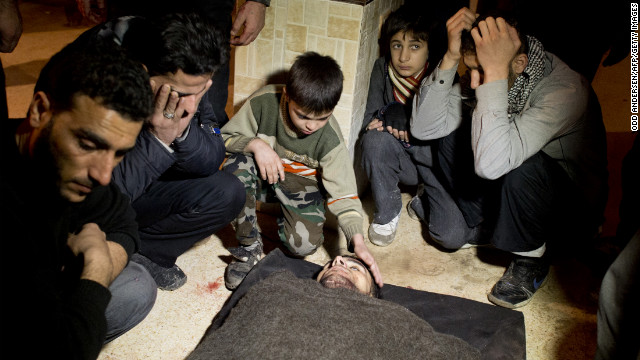 Photos: Showdown in Syria
Photos: Showdown in Syria 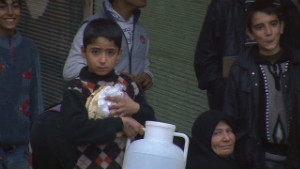 Cold, hunger add to misery in Aleppo
Cold, hunger add to misery in Aleppo 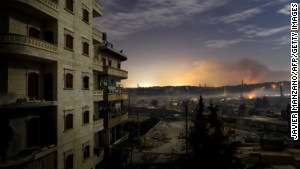 U.S. plans for possible Syria strike
U.S. plans for possible Syria strike 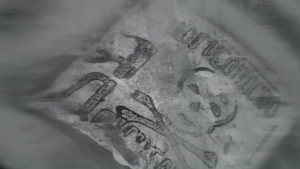 Syria ready to use WMDs?
Syria ready to use WMDs? 

 US, Russian Experts Set to Meet with Syria Envoy Brahimi
US, Russian Experts Set to Meet with Syria Envoy Brahimi

 Alleged victims of a Syrian chemical attack seen in a screen capture from a YouTube video uploaded by Syrian rebels on Saturday, December 8, 2012
Alleged victims of a Syrian chemical attack seen in a screen capture from a YouTube video uploaded by Syrian rebels on Saturday, December 8, 2012


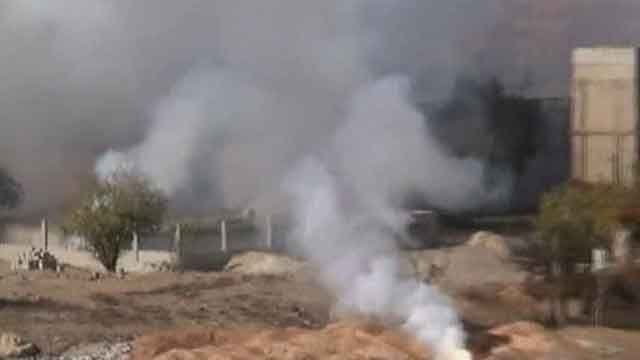




 Israel used White Phosphorus against HAMAS targets in Gaza during Operation Cast Lead in January 2009. This violated no international laws or conventions.
Israel used White Phosphorus against HAMAS targets in Gaza during Operation Cast Lead in January 2009. This violated no international laws or conventions. 










Bookmarks